In my 25 years experience with homoeopathy both in India, Europe and the United States, I have had the privilege of treating hundreds, if not thousands, of cases suffering with grave pathology. In India, particularly Calcutta and West Bengal, Homoeopathy is used as primary care and patients often opt for homoeopathy in preference to surgery. I believe this is due to a number of reasons:
1) Due to family tradition historically family members may have had successful homoeopathic treatment.
2) There is a faith and expectation that the consultant and experienced homoeopath can and will successfully treat pathology.
3) Lack of education results in a ‘lump’ or pain being neglected and results in severe pathology, which often finally arrives in the homoeopath’s clinic. [See 1 above]
4) Generally there is a wider awareness of the effectiveness and safety of homoeopathic medicine.
5) Sometimes, especially in very rural areas, there is no health care plan and people simply cannot afford the surgeon and nursing home fees.
Homoeopaths generally receive full time education in Universities over a five year period and have full medical understanding and the internship usually takes place in Government hospitals which prepares these doctors to have sufficient knowledge to practice in rural areas with limited facilities.
In India, the clinics are usually very full and it is not possible to spend a long time with each patient. To manage the number of patients in my practice, which I still maintain even though I reside in the U.K, I travel 4-5 times a year to practice in the Bengal Allen Medical Insitute in Calcutta. Effectively, I have developed an extensive questionnaire which the patient completes prior to the appointment. On arrival, my assistant doctor takes and confirms details written on the questionnaire and takes notes from the medical investigations, e.g. ultra sonography, x rays, etc. In this way, I can discuss the important highlighted homoeopath’s points with the patient and the family members attending. Then I physically examine the patient to confirm any findings from the report and the patient has further examinations from my clinical assistant; e.g., blood pressure, weight, etc. Then I assess the case miasmatically and from Materia Medica knowledge I conclude the consultation by writing the single remedy prescription. I have practised successfully in this way for over 25 years and have satisfying results.
In order to successfully treat pathology, the homoeopath should have sufficient confidence in the science and be properly trained in medical sciences to be safe and aware of the depth and scope of homoeopathy as well as the limitations and realistic expectations. Please visit our website www. homoeopathy-course.com (on this site under “Cured Case Gallery”, there are over 70 cases of pathology cured with homoeopathic treatment, sometimes with graphic pictures and medical records before and after treatment).
Below please find some cases with an explanation of how the remedy was selected and evidence of the before and after treatment.
PRACTICAL MIASMATIC DIAGNOSIS
MTEK is a memory aid useful for arriving at a correct prescription.
| M |
= |
Miasmatic Totality |
|
T |
= |
Totality of Symptoms |
|
E |
= |
Essence (should include gestures, postures, behaviours etc) |
|
K |
= |
Keynotes (which should encompass PQRS symptoms, refer §153 and §209 of Hahnemann’s Organon) |
When the above criteria are considered and the steps below followed, a correct prescription can be made.
|
Step-I: |
Make the miasmatic diagnosis of the case- i.e. ascertain the surface miasm. |
|
Step-II: |
Assess the Totality of Symptoms + Essence + Keynotes and PQRS (if any) of the case and formulate the indicated remedy. |
|
Step-III: |
Ensure that the indicated remedy covers the surface miasm, as diagnosed in Step I. |
|
Step-IV: |
Administer the remedy, which encompasses the miasm as well as the Totality of Symptoms. |
ANALYSIS OF THE CASE
(a) Head to foot assessment of symptoms (please refer to Miasmatic Prescribing, 2nd extended edition by Subrata K. Banerjea).
(b) Through clinical manifestation of disease, e.g. hypo/scanty/less are psora (e.g. hypotension, atrophy, anaemia, etc.); hypers are sycotic (e.g., hypertension, hypertrophy, hyperplasia etc.); dyses are syphilitic (e.g. dystrophy, dysplasia etc.) and allergies and haemorrhages are tubercular (e.g., hay fever, menorrhagia, etc.).
(c) Through psychic essence, nature and character of the individual case (e.g., suspicious, jealous and exploiting in nature represents sycosis; destructive and cruelty to animals represents syphilis; stubborn, changeable and impatient natures are tubercular, etc.)
(d) We can diagnose the miasm from other different aspects; e.g., reference to hair falling: alopecia with dry lustreless hair and bran-like dandruff is psora; circular or spotty baldness is sycotic; diffused hair falling is syphilitic, and thick yellow crusts in the hair are tubercular; in reference to taste: burnt is psoric; fishy is sycotic; metallic is syphilitic and taste of pus is tubercular; in reference to pulse: bradycardia is psoric; tachycardia is sycotic and irregular pulse is syphilitic; in reference to bowels: constipation is psoric; diarrhoea is sycotic; dysentery is syphilitic and malaena is tubercular; in reference to pains: neuralgic pains are psoric; joint pains are sycotic; bone pains are syphilitic and pains with exhaustion are tubercular.
(e) Diathesis (tendencies/pre-disposition) can also hint at the miasm: eruptive diathesis is psoric; rheumatic-gouty, lithic-uric acid or proliferative diathesis is sycotic; suppurative-ulcerative is syphilitic and haemorrhagic diathesis is tubercular.
(f) Psoric secretions are watery, mucussy, serous; sycotic secretions are purulent, yellowish; sticky, acrid, putrid and offensive are syphilitic and haemorrhagic secretions/discharges are tubercular.
(g) If you ask your patient what his hobbies are: ‘hunting’ reflects syphilitic taint; ‘travelling’ is tubercular, whereas ‘gambling’ is sycotic!
(h) Ask your patient: ‘If you could take a week off and money would be no object, what would you do?’ Mr. Psora is lazy and will do nothing; Mr. Tubercular will go on a round the world trip! Thereby you understand the innate dyscrasia and miasmatic nature of your patient.
(i) Miasmatic diagnosis can be made from nail appearance; e.g., dry harsh nails are psoric; thick, wavy, ribbed, corrugated, convex nails are sycotic; thin, spoon shaped concave nails are syphilitic and glossy and spotted nails are tubercular.
(j) Miasmatic observation of children: nervous, anxious, constipated children are psoric; restless, hyperactive (ADHD), colicky, diarrhoeic children are sycotic; withdrawn, dull, extremely forgetful, convulsive, dysenteric children are syphilitic and allergic, haemorrhagic, stubborn, impatient children are tubercular.
By such a prescription, which covers the miasmatic dyscrasia of the person, the chances of recurrence are eradicated and the axiom of ‘rapid, gentle and permanent recovery’ (Hahnemann’s Organon §3) is encompassed. In cases of one-sided disease with a scarcity of symptoms, the action of the anti-miasmatic remedy is centrifugal, and by bringing the suppressed symptoms to the surface, allows a proper totality to be framed.
CASE OF CEREBRAL ATROPHY COMPLETELY CURED BY NATRUM MURIATICUM
41 year old Married Male.
PRESENT COMPLAINTS
(1) Vertigo Sensation as if everything around him is whirling around, with blurred vision; ameliorates in open air, ameliorates by fanning. (2) Hemicrania – Alternating sides. Sometimes the entire head feels heavy and aches violently. Mild pain in occipital region and forehead. (3) Occasional oppression in breathing, with occasional creeping pain in right chest and uneasiness feelings. (4) Greasy oily face. (5) Talks loudly when asleep. (6) Vertigo aggravates with motion, slightest exertion, night, ameliorates by lying down. Aggravates from cold. noise (+++), Jar (++), Pressure, intercourse, anger, irritation, consolation, during full moon. (7) Ameliorates by bathing. (8) HEAD – Burning of vertex and sometimes hot. (9) EYE – Blurred vision : cloudiness of sight with vertigo. (10) EAR – N.P. (11) NOSE – Occasional nose block with thin watery coryza. (12) MOUTH – Occasional apthae. (13) TEETH – Pain left side of teeth aggravated by cold drink. (14) TONGUE – Coated tongue, looks like mapped. (15) THROAT – Sore throat from cold, most painful : on the left side. (16) LUNGS – Very Occasional dry cough from exposure to cold. (17) HEART – Light feeling in chest especially during vertigo. (18) CHEST – Nothing particular. (19) ABDOMEN – (a) Gas and distension with discomfort around umbilicus, (b) Eructation ameliorates, (3) More the gas, more the vertigo and giddiness. (20) STOMACH – Appetite: average. (21) SWEAT – Sweat: average. (22) URINE – Stress incontinence – involuntary urination while laughing and sneezing. (23) STOOL – (1) Hard stool, (2) Constipation with ineffectual desire. (24) UPPER EXTREMETIES – (1) Occasional joint pains aggravate on waking. (25) PALM – Nothing particular. (26) JOINTS – Occasional pain in Knee, more in the left. Pain back: aggravation after long standing or sitting, relieved by hard pressure, pressing the back with a pillow. (27) LOWER EXTREMITIES – Nothing particular. (28) MALE GENITAL ORGANS – (1) Lax penis, (2) Sexual power: deficient. (29) FEMALE GENTAL ORGANS – Nothing abnormal. (30) ANUS – (1) Occasional rectal irritation and pain, (2) Relieved by itching. (31) SKIN DISEASE – Itchy groin aggravates while undressing. (32) Angry or irritable temper, Fault-finding. (33) Suspicious mood, Jealous. (34) Talkative. (35) Neat and Clean, Wants to be alone +++. (36) Fear of death, Disgusted with life, Defensive and resentful especially regarding his illness. (37) Memory: Active. (38) Weeping mood and does not entertain consolation, more angry. (39) Hurry. (40) Fear of ghost, darkness, thunderstorm ++, incurable disease, failures ++. (41) Mental worry, grief, death of dear ones. (42) History of Bronchitis during childhood. (43) History of Jaundice in 1984. (44) Had chicken pox once. (45) Hot person. Desires open air. (46) Catches cold easily. Desires and Aversions. Sweet + Sour No Pungent and hot, No Salt ++ Salty +++ Bitter No Bread No Milk + Potato + Vegetables and Spinach Average Onion + Fruits + Fish ++ Meat/Chicken ++ Egg (Boiled/Fried) + Rich, spicy and fat food Aversion (loathes) Warm food +++ Cold food Aversion Warm drinks + Cold drinks + Ice cream : Average. (47) Thirst: Poor. (48) SLEEP – Disturbed sleep, head feels heavy, wakes up. (49) Patient is occupied with dreams and thinks of it, even after waking in the morning and he behaves like the dream was reality. (50) Married with two children (girls). (51) FAMILY HISTORY – HISTORY OF Rheumatism in the family. (52) Past treatment included both allopathic and homoeopathic medicines without any appreciable change.
INVESTIGATION DONE BEFORE / AFTER
Investigation done before treatment. 2nd Feb 1990. Chest X-Ray :- A small area of resolving congestion at the lower lobe of right hilum and right cardio-hepatic angle. No parenchymal infiltration seen. Cardiac silhouette normal.
11th May 1990:- Skull X-Ray: Normal.
22nd May 1990:- CT Scan Brain: The CT Scan Brain reveals minimal diffuse cerebral atrophy.
29th May 1990:- Chest X-Ray :- Nothing abnormal detected.
9th May 1991:- X-Ray Para-Nasal Sinus: Mild Right Maxillary Sinusitis. No fluid.
3rd Nov 1992:- CT Scan Brain: Normal plain and contrast enhanced CT Scan of Brain.
CASE ANALYSIS, MIASMATIC DIAGNOSIS AND FINAL PRESCRIPTION
There are two approaches in a case like this; e.g, Cerebral Atrophies, Senile Dementia, etc. where you can either open the case with a polychrest on the basis of the totality (if conspicuously available), or it is necessary to prescribe a lesser known medicine on the basis of the few symptoms available in the surface and the corresponding organopathic medicine by which more symptoms will surface. Here I found a good totality and accordingly have prescribed a polychrest.
MIASMATIC ANALYSIS
(1) Vertigo – sensation as if everything around him is whirling around- Sycotic. (2) Vertigo: ameliorates in open air, ameliorates by fanning-Psora-tubercular. (3) Hemicrania – alternating sides: Tubercular. (4) Greasy oily face: Syco-syphilitic. (5) (i) Vertigo aggravates by motion, slightest exertion: Psora; (ii) Aggravation at night: Syphilitic; (iii) Ameliorate by lying down : Psora. (6) NOSE – Occasional nose block : Sycotic. (7) THROAT – Sore throat from cold : Syphilo-tubercular. (8) URINE – Stress incontinence – involuntary urination while laughing and sneezing : Syco-Syphilitic. (9) JOINTS – Occasional pain in Knee, more in the left. Pain back : aggravation after long standing or sitting, relieved by hard pressure : Sycotic. Pressing the back with a pillow: Sycotic. (10) MALE GENITAL ORGANS – (i) Lax penis – Psora, (ii) Sexual power: deficient – Psora. (11) Angry or irritable temper, Fault-finding : Sycotic. (12) Suspicious mood, Jealous : Sycotic. (13) Talkative: Sycotic. (14) Wants to be alone : Syphilitic. (15) Fear of death: Psora; Disgusted with life :syphilitic. (16) Hurry : Sycotic. (17) Fear of ghost, darkness, thunder-storm, incurable disease, failures : Psora. (18) Mental worry, grief, death of dear ones : Psora. (19) Desire : Salt, Salty : Syco-tubercular.
FINAL PRESCRIPTION
NATRUM MURIATICUM, 200 C
|
Date |
Prescription done on the basis of |
Treatment |
|
28thSep 90 |
(1) Considering vertigo with blurred vision ameliorated by lying down, open air, aggravate from motion and exertion and noise (+++), (2) Appearance of the face: greasy and oily, (3) Dreams of robbers and fire and moreover occupied in the fantasy of the dream even after waking as from reality, (4) Appearance of the tongue, (5) Toothache aggravate from cold drink, (6) Stress incontinence – in urine, (7) Temperament irritable (++), fault-finding person, (8) Weepy but does not entertain consolation, (9) Fears thunderstorm. Defensive and resentful especially regarding his illness. (10) Desires – salt, salty but loathes fatty. |
Nat. Mur, 200 : 2 doses in water : to be taken alternate weeks. |
|
3rdNov 90 |
No change in vertigo but temperamentally better; less irritation and tension : wait and watch. |
No medicine |
|
14thDec 90 |
Temperamentally much better but vertigo and reeling still persist. Blurred vision little improved. Repeat. |
Nat. Mur, 200 : 2 doses : alternate weeks. |
|
21stJan 91 |
No further change. Stand still (wait for further movement of symptoms). |
No medicine. |
|
13thFeb 91 |
Stand-still status. |
Natrum Muriaticum, 1M : 2 doses : alternate weeks. |
|
5thMar 91 |
(1) Blurring of the vision : much better; but vertigo though 10% to 15% relieved but still very much there. |
No medicine |
|
26thApr 91 |
Stand still. Go higher (As frontal and occipital pain was complained also: so advised to undergo an X-Ray Para Nasal sinus). |
Natrum Mur, 10M : 2 doses : alternate weeks. |
|
31stMay 91 |
(1) X-Ray shows mild right maxillary sinusitis, (2) Vertigo 70% better, (3) Dreams and stress incontinence much improved, (4) Hemicrania or oppressed breathing, loud talking during sleep, joint pains better, (5) Less fault finding, now easy-going, less fears and takes interest in life (no disgust feeling). |
No Medicine |
|
Date |
Prescription done on the basis of |
Treatment |
|
8th Jul 91 |
Same as before (Wait) |
No medicine |
|
5thAug 91 |
No further change. Very slow movement of symptoms. Repeat. |
Natrum Mur, 10 M : 2 doses : alternate mornings. |
|
4thSep 91 |
Patient feeling better. |
No medicine |
|
28thSep 91 |
Much better. Vertigo and reeling almost gone. Doing much better. Wait. |
No medicine. |
|
26thOct 91 |
Doing better in every regard (1) Temperamentally a totally different person, (2) Happy, amiable, easy going, extroverted, likes to mix with people, (3) Headache and vertigo : all disappeared, (4) Food habit changed : he likes and enjoys his spicy Indian meal, these days ! C.T. Scan Brain reveals Nothing Abnormal Detected : Conclusion : Cured Case. |
No medicine. |
A DIAGNOSED CASE OF CYSTIC HYGROMA OF NECKBEAUTIFULLY CURED BY CALCAREA IODATUM
3 months old baby (as on 17th November, 1998)
Present Complaints
(1) Large lump of the right side of neck. (2) At birth there was a nodule the size of a small lime which had rapidly grown and by the age of 2 months it was almost the size of a large grapefruit. The mass is not painful and is of a soft, cystic texture. (3) The patient, was taken to a Paediatric Surgeon who gave the aforesaid diagnosis and advised operation, but also mentioned there are chances of recurrence even after surgery. The parents had decided not to go for surgery, opted doe Homoeopathy and brought the baby to me. (4) The baby also had some acute cough for the last 15 days, which might be due to exposure to cold. Occasional vomiting with expectoration of white mucous. (5) Stool: offensive, dry, hard, occasionally contains mucous. (6) Mental Symptoms: Mild, generally quiet and appears to be in his own world, not very much communication (though a very young baby with a large tumour). (7) The mother of the baby said that the baby is decidedly hot, tends to kick covering; if covered, becomes cranky. (8) Cervical lymph gland on the other side (left) of the neck is swollen+++. (9) Desire: Sweet++, Sour+, Salt+, Cold food+ (this was not revealed initially because he was a tiny baby and did not have any particular preference for flavours, but revealed at the age of 16 months). (10) Thirsty+. (11) Sleep: Ok. (12) Sweat profusely on head. Occasionally smells sour.
CASE ANALYSIS, MIASMATIC DIAGNOSIS AND FINAL PRESCRIPTION
This case is a wonderful example about the depth and beauty of classical Homoeopathy which can handle such pathology. The parents of the baby were not happy with the prognosis given by the Surgeon, therefore, Homoeopathy accepted the challenge!
MIASMATIC ANALYSIS
(1) Large lump : Sycotic. (2) Lump soft, cystic texture : Sycotic. (3) Stool, dry, hard : Psora. (4) Mild, generally quiet and appears to be in his own world: Psora (can be Psora-Syphilitic, as withdrawn can be Syphilitic as well). (5) Cervical lymph gland on the other side (left) of the neck is swollen: Tubercular. (6) Desire : Sweet : Psora. (7) Sweat profusely on head: Sycotic. (8) Sweat smells sour: Psora. (9) Mixed Miasmatic case with Syco-Tubercular preponderance.
FINAL PRESCRIPTION MADE ON THE BASIS OF
(1) Large lump on the neck. (2) Started as a nodule, grew larger and became a soft cystic mass. (3) Stool: dry, hard. (4) Mental Symptoms : Mild, generally quiet and appears to be in his own world, not very much communication (I took it as withdrawn). (5) Hot patient. (6) Cervical lymph gland on the other side (left) of the neck is swollen+++. Glandular involvement. (7) Desire: Sweet++, Sour+, Salt+, Cold food+. (8) Thirsty+. (9) Sweat profusely in head. Occasionally smells sour. (10) Miasmatic coverage as well.
FINAL PRESCRIPTION
CALCAREA IODATUM, 200 C: 1 globule (No. 10: poppy seed size) in sugar of milk sachet. Asked the parents to dissolve the powder in 8 ounces of pure water (preferably in his feeding bottle), shake and administer slowly throughout the day. Save a little at the bottom, top it up next morning, keep sipping throughout the next day. Generally I give instructions to my patients to dilute the medicated water (top it up with water) as many times as s/he likes. Continue like this for 7 days. Then 7 days of no medicine. Followed by another dose to be shaken and sipped for 7 days.
PRESCRIPTION CHART
|
Date |
Prescription done on the basis of |
Treatment |
|
17thNov, 98 |
As discussed above. |
Calcarea Iodium 200, 2 doses |
|
25thNov, 98 |
Patient’s parent thinks the baby is little better. |
No medicine |
|
15thFeb, 99 |
Doing better. Mass is better; Stool – Ok. |
No medicine |
|
12thApr, 99 |
Mass is reducing. |
No medicine |
|
15thJun, 99 |
Doing better. Mass is better. Some skin eruption appeared, could be surfacing of Psora. Wait and watch. Ask to apply some plain coconut oil and nothing else. Report if aggravation or a spreading. |
No medicine |
|
10thAug, 99 |
Mass decreased. Skin diseases better – Emotionally more communicative and becoming restless. Sleep – Ok., Stool – OK. As a whole swelling, 60% better. |
No medicine |
|
12thOct, 99 |
Symptoms same as before. Wait and watch. |
No medicine |
|
4thDec, 99 |
Appears to be stand still status. |
Calcarea Iod, 200, 2 doses |
|
4thFeb, 00 |
No further appreciable change. |
Calcarea Iod, 1M, 1 dose |
|
8thApr, 00 |
Little better. As a whole swelling, 70% better. |
No medicine |
|
3rdJun, 00 |
No further appreciable change. |
CalcareaIodium, 1M, 2 doses |
|
15thJul, 00 |
Little better. As a whole swelling, 80% better. Mentally more alert and reactive. |
No medicine |
|
12thSep, 00 |
No further appreciable change. Mass – Stand still. |
CalcareaIodium, 10M, 1 dose |
|
27thOct, 00 |
Mass is reducing in size. Wait and watch. |
No medicine |
|
22ndDec, 00 |
Mass is better almost 95% gone but appears to be stand still since mid November’00, otherwise better. |
CalcareaIodium, 50M, 1 dose |
|
28thJan, 01 |
Mass completely disappeared. |
REMEDY REACTION
I began with CALCAREA IODATUM, 200 C and gradually ascended up to 50 M in 2 years time. Within 3 months after starting my treatment, the mass started reducing and within 8 months, it came down to the size of a small lime. In 2 years time, it has totally disappeared.
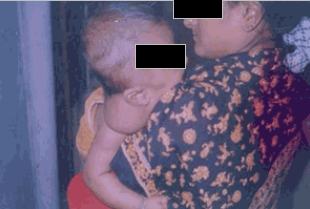
Baby S.M., massive swelling (diagnosed as Cystic Hygroma), before treatment.
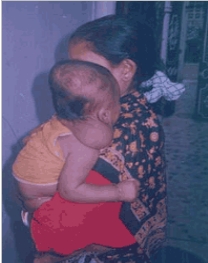
Before homoeopathic treatment.
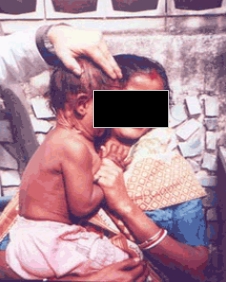
Decreased swelling, 3 months after homoeopathic treatment.
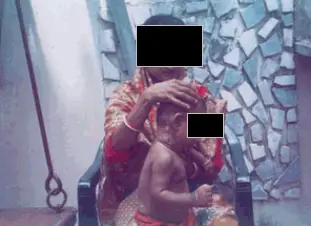
Swelling decreasing, 8 months after homoeopathic treatment.
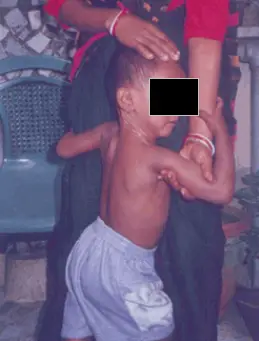
Swelling decreasing, 12 months after homoeopathic treatment.

Swelling completely decreased 22 months after treatment.

Cured case.
A CASE OF PLEURAL EFFUSION COMPLETELY CURED BY HOMOEOPATHY
An allopathic physician of 53 years visited me on 27th May 1989 with the following complaints: (1) Since first week of February ’89 the problem started with high rise of temperature. Severe dyspnoea and pain in the left lateral side of the chest aggravated by respiratory movements, ameliorated by lying on left side. (2) Physical signs were: movement of the left chest wall was reduced with stony dull on percussion. Breath sounds diminished. Pleural rub were present. (3) Pain felt on deep breath and yawning. Pain more on the left lower and lateral part of the chest and little towards the back. (4) Feverish always with frequent high rise of temperature, cough followed by dyspnoea, aggravated in the evening. (5) Sense of heaviness in the left part of the chest. (6) Dry lips. (7) Cough, and has to sit up, aggravated after eating. (8) Likes to expand his chest but cannot. (9) Mild temperament. Likes to be neat and clean. No fears. (10) Likes fresh foods.
LABORATORY INVESTIGATIONS
(1) 5th Feb’89 :- Hb% :- 78%, ESR- 65, Xray Chest – Consolidation with collapse of left lower zone with Pleural Effusion. 16th Feb’89 :- B.S.P.P. – 135. 24th Feb’89 :- Chest Xray – Translucent cresentric outline is seen above the dome. 30th Jun’89 :- Xray chest – No pleural thickening at the left. Costo-phrenic angles are clear. (2) Provisional diagnosis :- Pleural Effusion. (3) Miasmatic diagnosis :- Mixed Miasmatic. (4) Constitutional remedy :- Bryonia.
PRESCRIPTION CHART:
|
Date |
Report after last medication |
Prescription done on the basis of |
Treatment |
|
27thMay’89 |
(1) Warmer days after winter. (2) Pain aggravated by movement, better by pressure. (3) Pain ameliorated by lying on painful side. (4) Synovial effusion. (5) Dry lips. (6) Sense of heaviness in the chest, around sternum, more in the left. |
Bryonia 12:2 doses : each dose given in water, to sip throughout the day. [2 doses : Alternate days]. |
|
|
14thJun’89 |
Feeling better, fever, cough, dyspnoea improved. |
Wait & watch |
No medicine |
|
24thJun’89 |
As a whole improving |
Wait & watch |
No medicine |
|
15thJul’89 |
Much better, cured of his complaints. |
Go higher to prevent any relapse |
Bryonia 200:1 dose |
Authenticity of cure can be viewed at:
http://www.homoeopathy-course.com/case/case6/case06.html
POINTS IN FAVOUR OF BRYONIA (ADDITIONS)
Dr. Farrington suggests, owing to accompanying inflammation of the pleura, sharp pleuritic stitches are felt in the chest. They are worse on left side. The patient complains of heavy pressure, just over the sternum. The pulse is full, hard and tense (Farrington). Occasionally in Bryonia you may find in cases of pleurisy or pneumonia, there is heat in the chest (Clarke). Continued inclination to draw a long breath (Clarke). Dr. Clarke says “must expand the chest” is a characteristic.

Chest X-Ray (Complete Collapse of Left Lung) of Dr. SKC, a case of Pleural effusion, before treatment.

Chest X-Ray, before homoeopathic treatment.

Chest X-Ray report of Dr. SKC, before homoeopathic treatment.

Cured Chest X-Ray only 4 months after treatment.

Cured Chest X-Ray report only 4 months after treatment.
A CASE OF RETROPERITONEAL PELVIC MASS (ABDOMINAL TUMOUR) IN A 39 YEARS OLD MALE, COMPLETELY CURED BY BRYONIA
39 year old married male
PRESENT COMPLAINTS
Pain on the Left side of lower abdomen, better by pressure. (2) Constipation. Occasional rounded ball like stool. (3) Gas in abdomen. (4) Pain from umbilicus towards lower abdomen, after urination. (5) Pain felt at left side of lower abdomen during walking. (6) In the month of March, 1995 at about 11.00 p.m., abdominal pain and vomiting started two hours after eating. (7) Indigestion, stool not clear. (8) Weakness++. (9) Profuse wind forms in abdomen; aggravates in the afternoon; ameliorates by passing of flatus. (10) Thirsty. (11) Hot patient. (12) Profuse sweating++ ? bad odour in sweat. (13) Desire for Sour +++; Salty++, Pungent; Bitter; Vegetable and spinach; Fish, Luke warm food; Cold drinks. Aversion to sweet. (14) Mind: Irritable temperament (+++); talkative; desires for company; patient cries when reprimanded. Insecurity. (15) Very business minded and materialistic. Has mentioned a few times during the consultation and the follow-ups about insecurity and instability of the world’s economics. I felt like economy is the centre of all his conversations.
INVESTIGATION DONE BEFORE / AFTER
18th April, 1996 Before Treatment USG whole abdomen: Large retroperitoneal pelvic mass.
29th March, 98 After treatment USG whole abdomen :- Nothing Abnormal Detected.
CASE ANALYSIS, MIASMATIC DIAGNOSIS AND FINAL PRESCRIPTION
This is an interesting case of large abdominal tumour (according to ultra sonogram, can be cystic) and patient felt it was growing. Also pain and other discomforts were there.
MIASMATIC ANALYSIS
(1) Pain at left side of lower abdomen, better by pressure : Sycotic. (2) Constipation. Rounded ball like stool occasionally: Psoric. (3) Weakness : Mostly psoric, can be Psora-tubercular. (4) Profuse wind forms in abdomen: Psora. (5) Profuse sweating: Sycotic. (6) Desire for Sour: Psora; Salty: Sycotic; Pungent: Psora. (7) Mind: Irritable temperament : Syco-tubercular; Talkative : Sycotic; Insecurity : Sycotic. (8) Very business minded and materialistic : Sycotic.
FINAL PRESCRIPTION MADE ON THE BASIS OF
- Pain at left side of lower abdomen, better by pressure. (2) Constipation. Rounded ball like stool. (3) Pain feels at left side of lower abdomen during walking. (4) Thirsty. (5) Hot patient. (6) Profuse sweating++ ? bad odour in sweat. (7) Desire for Sour +++. (8) Mind : Irritable temperament (+++). Insecurity. (9) Very business minded and materialistic. Concerned about insecurity and instability of the world economics. I felt like economy is the centre of all his conversations. (10) I have given emphasis on his mental essence which reflected materialism and very much concerned about economy which in term reflected his insecurity and anxiety about future. With such a mental essence in background, he had this large abdominal tumour with pain better by pressure, etc. and accordingly Bryonia was selected.
FINAL PRESCRIPTION
BRYONIA, 200 C : 1 globule (No. 10 : poppy seed size) in sugar of milk sachet, asked the patient to dissolve the powder in half or one litre of pure water and sip it slowly throughout the day, save a little at the bottom, top it up next morning, keep sipping throughout the next day. Asked my patient to dilute the medicated water (top it up with water) as many times as he likes. Continue like this for 7 days. Then 7 days of no medicine. Followed by another dose to be shaken and sipped for 7 days.
REMEDY REACTION
Patient’s response to Bryonia was very satisfactory. After 200C, I waited for 2 months and constipation was better and pain was lessened. Emotionally a little bit relaxed (not much though). I have repeated 200 C twice, and after 6 months from the initial treatment, I went to 1M and the changes were dramatic. Physical symptoms abated significantly. Pain and vomiting were 90% better, including indigestion, gas and sweating. I waited for 4 months and then repeated 1M another time, but felt a stand still status, and then went to 10M and with this dose the mental symptoms have significantly improved, including the feeling of insecurity. As the pain was totally absent, I have asked to repeat the Ultra sonography and the result was very satisfactory. The large retroperitoneal tumour has disappeared with the action of homoeopathy! Patient was cured in about 16 months.
Courtesy: Hpathy.com
